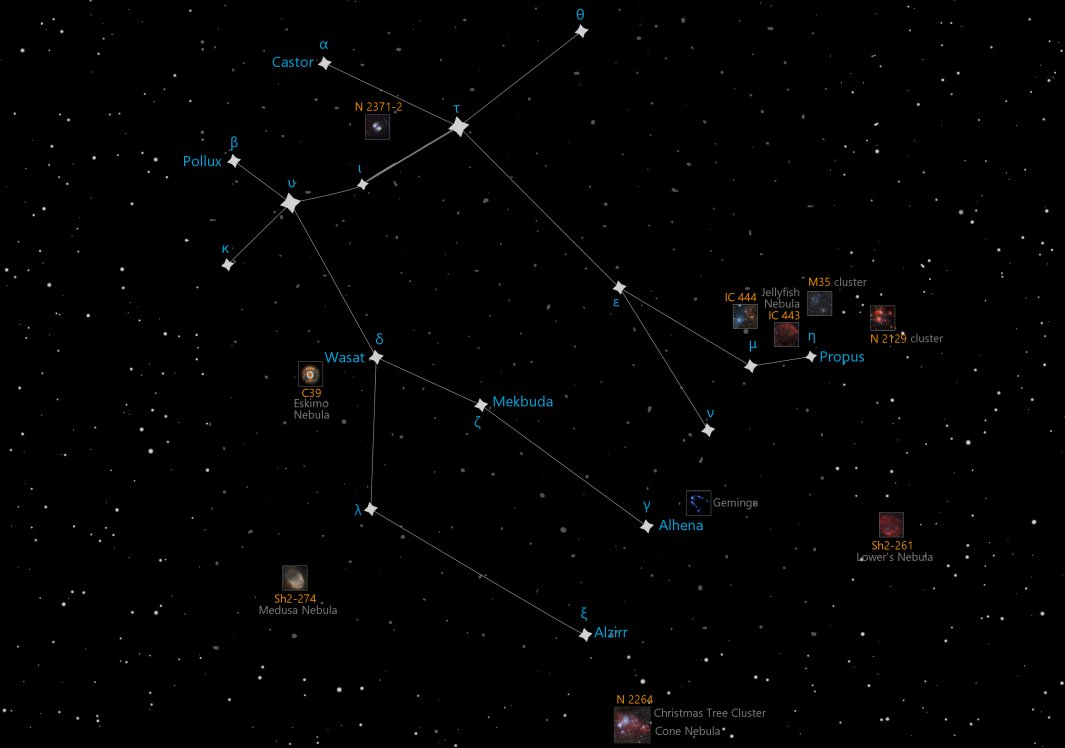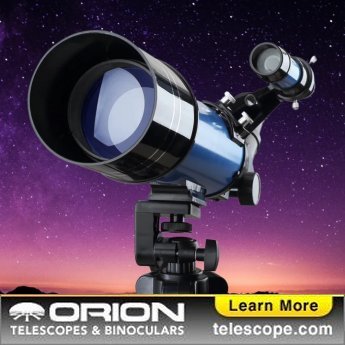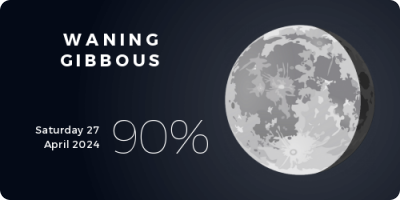Gemini, the Twins (Gem)
(JEM-uh-nye)
The Northern constellation of Gemini, the Twins, is best viewed in Winter during the month of February.
Gemini is the 30th largest constellation. It's brightest star is Pollux at magnitude 1.15. The boundary of the Gemini constellation contains 11 stars that host known exoplanets.
- Pronunciation:
- JEM-uh-nye
- Meaning:
- Twins
- Genitive:
- Geminorum
- Abbreviation:
- Gem
- Constellation Family:
- Zodiacal
- Hemisphere:
- Northern
- Quadrant:
- NQ2
- Visibility:
- 90° N - 60° S
- Best viewing month*:
- February
- Area:
- 514 sq. degrees
- Size:
- 30th largest
- Right Ascension (avg):
- 6h 51m
- Declination (avg):
- 23°
- Meteor showers:
- Geminids
- Brightest star:
- Pollux (1.15)
- Stars with planets:
- 11
Brightest Stars in Gemini
The 10 brightest stars in the constellation Gemini by magnitude.
- Star
- Magnitude
- Spectral class
- Beta Geminorum (β Gem)
- 1.16
- K0III
- Alpha Geminorum (α Gem)
- 1.9
- A2Vm
- Gamma Geminorum (γ Gem)
- 1.93
- A0IV
- Mu Geminorum (μ Gem)
- 2.87
- M3.0III
- Alpha Geminorum (α Gem)
- 2.88
- Epsilon Geminorum (ε Gem)
- 3.06
- G8Ib
- Eta Geminorum (η Gem)
- 3.31
- M3III
- Xi Geminorum (ξ Gem)
- 3.35
- F5IV
- Delta Geminorum (δ Gem)
- 3.5
- F0IV
- Kappa Geminorum (κ Gem)
- 3.57
- G8III
Double Stars in Gemini
These are the brightest and easiest-to-find double, triple, and quadruple star systems in the constellation Gemini. Also see all star clusters.
- Star system
- Magnitudes
- Type
- Delta Geminorum
- 3.6, 8.2
- double
- Alpha Geminorum
- 1.9, 3.0
- double
Star Clusters in Gemini
The most notable and easy-to-find star clusters in the constellation Gemini . Also see all star clusters.
Nebulae in Gemini
Notable and easy-to-find nebulae in the constellation Gemini . Also see all nebulae.
- Nebula name
- Catalog #
- Nebula type
- Eskimo Nebula
- C39
- planetary
- Jellyfish Nebula
- supernova remnant
- Medusa Nebula
- planetary
Neutron Stars in Gemini
These are the most well-known neutron stars in the constellation Gemini. Although neutron stars cannot be seen in any amateur telescope, they are at the center of many supernova remnant nebulae, which can be seen. Also see all neutron stars.
Black Holes in Gemini
These are the most well-known smaller (non-supermassive) black holes in the constellation Gemini. Although black holes cannot be seen directly, the smaller ones are at the center of some star clusters and supernova remnant nebulae, which can be seen. Supermassive black holes are at the center of most galaxies, such as Sagittarius A* at the center of our Milky Way galaxy. Also see all black holes.
- Black hole
- Type
- LB-1
- stellar
The Celestial Twins
Gemini, Latin for "twins", is a prominent constellation in the Northern Hemisphere's winter sky. It is one of the 48 ancient constellations described by the 2nd century astronomer Ptolemy, and it remains today one of the 88 modern constellations defined by the International Astronomical Union (IAU). This constellation is rich in history, myth, and scientific interest, making it a favorite among astronomers and star-gazers alike.
Historical Overview
Known in mythology as Castor and Pollux, the heavenly twins have been recognized in the night sky by many cultures throughout history. In Greek mythology, despite being twins, they had different fathers. Castor was the mortal son of Tyndareus, the king of Sparta, while Pollux was the divine son of Zeus. When Castor died, Pollux asked Zeus to grant Castor immortality, and they were transformed into the constellation Gemini.
Location and Main Features
Gemini is located between Taurus to the west and Cancer to the east, with Auriga and Lynx to the north and Monoceros and Canis Minor to the south. It lies in the second quadrant of the Northern Hemisphere (NQ2) and is visible at latitudes between +90? and -60?. Covering an area of 514 square degrees, it is the 30th largest constellation in the sky.
Major Stars
Gemini's brightest stars, Castor and Pollux, represent the heads of the heavenly twins. Pollux, also known as Beta Geminorum, is the brighter of the two, despite its 'Beta' designation. It is an orange giant of spectral type K0 III, located about 34 light-years away, and has an apparent magnitude of 1.14. Pollux is the 17th brightest star in the sky and has at least one confirmed exoplanet.
Castor, or Alpha Geminorum, is actually a six-star system located approximately 51 light-years away from Earth. The system is composed of three binary pairs: Castor A, B, and C. Despite being the 'Alpha' star of Gemini, it's slightly fainter than Pollux, with an apparent magnitude of 1.58.
Deep Sky Objects
Gemini hosts several notable deep-sky objects. These include the open cluster Messier 35, the Eskimo Nebula (NGC 2392), and the Medusa Nebula (Abell 21). Messier 35 is an open cluster that is approximately 3,870 light-years away, easily visible in small telescopes. The Eskimo Nebula, a planetary nebula, got its name because when viewed through a telescope, it appears to have a face surrounded by a fur parka. The Medusa Nebula is an old planetary nebula that is difficult to observe due to its low brightness.
Observation
Gemini is best observed during the months of January to March. Even though its stars are not among the brightest, they can easily be spotted on a clear, dark night. The two main stars, Castor and Pollux, form a prominent sight as they represent the heads of the twins, with their bodies stretching out towards the constellation of Cancer.
Gemini in Modern Astronomy
Gemini has played a key role in space exploration. The name of NASA's Gemini program, which was a bridge between the Mercury and Apollo programs, was derived from this constellation due to the project's focus on developing techniques for two astronauts to work in space together, much like the mythical twins working together.
* Constellation shown for northen hemisphere skies. For the southern hemisphere, constellations appear rotated 180 degrees (upside-down and left-right reversed) from what is shown. Remember that seasons are reversed too - summer in northern latitudes is winter in southern latitudes.
** Circumpolar constellations are visible year-round in the hemisphere listed (and not at all in the opposite hemisphere).





